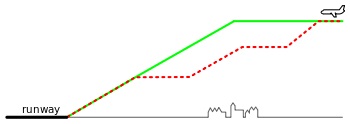Air Navigation Services - Flight Procedure Design
As the air navigation service provider for the Singapore Flight Information Region, CAAS is responsible for the design, validation, implementation and review of instrument flight procedures.
The goal of flight procedure designing is to develop a series of manoeuvres, during departure and approach to land, such that the aircraft is able to follow the most efficient trajectory. Reference from flight instruments and navigational aids is used to design these trajectories. A number of considerations such as airspace constraints, user requirements and Air Traffic Services requirements are also factored into the design.
As obstacle clearance is the primary safety consideration in developing instrument flight procedures, ICAO specifies detailed criteria to ensure the safety of such procedures including departures, en-route as well as arrivals and approaches. There are two examples of flight procedure design undertaken by CAAS:
Continuous Descent Operations (CDO)
Continuous Descent Operations (CDO) is an aircraft operating technique which enables the pilot to execute an optimised arrival descend profile using appropriate instrument flight procedure design and ATC procedures.
In CDO, the aircraft takes a continuously descending path (rather than a stairstep path with permission required from ATC for each descent) to enable smooth aircraft deceleration and configuration prior to an Instrument Landing System approach. New arrival flight routes have been constructed to facilitate CDO into Singapore Changi Airport.

(The conventional route is marked in red, while the route with CDO is marked in green.)
Performance-based Navigation (PBN)
Performance-based Navigation (PBN) is navigation capabilities that use satellite systems and equipment on board the aircraft, rather than traditional navigation capabilities based on ground sensor equipment. PBN procedures result in increased prevision and accuracy, hence allowing more flexible design of flight routes.
Benefits to aviation stakeholders include:
- Reduced infrastructure requirements
- Improved operational efficiency
- Improved safety
- Reduced environmental impact
- Increased airspace capacity

Air Navigation Services Regulation
CAAS is also responsible for the safety oversight of air navigation services in Singapore. In this aspect, CAAS conducts regular audits and inspections on the air navigation service provider (ANSP) to ensure that it remains competent at managing operations in accordance with regulatory requirements. These regulatory requirements can be found within:
- Manual of Standards (On air navigation services)
- Aeronautical Information Services (PDF, 130 KB)
- Aeronautical Telecommunication (PDF, 240 KB)
- Air Traffic Services (PDF, 6 MB)
- Instrument Flight Procedure Design (PDF, 102 KB)
- Licensing of Air Traffic Control Personnel (PDF, 449 KB)
- Search & Rescue (PDF, 1 MB)
- Manual of Standards (On meterological services)
Manual of Standards –Meteorological Service For International Air Navigation Volume I (PDF, 287 KB)
Manual of Standards –Meteorological Service For International Air Navigation Volume II (PDF, 4 MB)
CAAS publishes various materials targeted at the ANSP such as:
- Air Traffic Services Information Circulars
- Information Circulars (ICs) For non-regulatory, administrative matters, these circulars will keep you up to date on the latest information.
- Notice of Amendments Stay abreast of the latest amendments on the legislation and requirements through these notices.
- Air Traffic Services Safety Publications Air Traffic Services Safety Publications aim to promulgate supplementary guidance materials pertaining to the Standard and Recommended Practices in the Manual of Standards. Through recommendations, the publications illustrate how you can comply with the regulations.
These circulars highlights aviation safety educational materials to the ANSP. The publications could be initiated as a result of ICAO State letters, new safety initiatives or international best practices as identified by CAAS.
 ) or https:// as an added precaution. Share sensitive
information only on official, secure websites.
) or https:// as an added precaution. Share sensitive
information only on official, secure websites.
